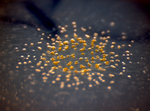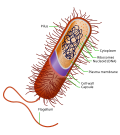The myxobacteria ("slime bacteria") are a group of bacteria that predominantly live in the soil and feed on insoluble organic substances. The myxobacteria...
17 KB (1,297 words) - 01:41, 9 October 2024
among the myxobacteria. Myxobacteria travel in swarms containing many cells kept together by intercellular molecular signals. Most myxobacteria are predatory:...
20 KB (2,226 words) - 08:24, 8 November 2024
can often aggregate in multicellular colonies. Some species such as myxobacteria can aggregate into complex swarming structures, operating as multicellular...
74 KB (7,752 words) - 15:13, 30 October 2024
rod-shaped bacteria. The family Myxococcaceae is encompassed within the myxobacteria ("slime bacteria"). The family is ubiquitously found in soils, marine...
7 KB (472 words) - 07:39, 5 January 2024
large colonies can create multilayered microbial mats. Others, such as myxobacteria, have multicellular stages in their life cycles. Prokaryotes are asexual...
44 KB (4,782 words) - 04:08, 8 November 2024
of the group myxobacteria. It is motile and shows gliding motility. Under stressful conditions this motility, as in other myxobacteria, the cells congregate...
7 KB (788 words) - 17:34, 2 May 2024
the elongated filaments of Actinomycetota species, the aggregates of Myxobacteria species, and the complex hyphae of Streptomyces species. These multicellular...
143 KB (15,534 words) - 20:00, 8 November 2024
methanogenic archaea, invaded and lived within bacteria similar to modern myxobacteria, eventually forming the early nucleus. This theory is analogous to the...
87 KB (9,963 words) - 07:20, 9 October 2024
methanogenic archaea, invaded and lived within bacteria similar to modern myxobacteria, eventually forming the early nucleus. This theory is analogous to the...
52 KB (5,473 words) - 21:00, 4 November 2024
biosynthetic pathways exist for the tetracyclic steroid framework (e.g. in myxobacteria) – where its origin from eukaryotes is conjectured – and the more-common...
83 KB (8,473 words) - 15:54, 30 October 2024









